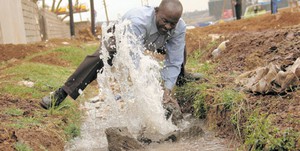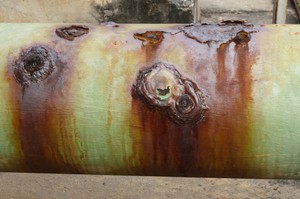Non-revenue water and leakage
Water that is supplied by water utilities has to be paid for, since the production and distribution of treated water costs money. (You will learn more about this in Study Session 13.) There is, however, a category of water supplied from which no income is derived for the water utility. This non-revenue water includes:
- water that is used by the water utility for maintenance purposes, for example for cleaning out pipes, reservoirs or tanks
- water that is not recorded as having been used, due to inaccurate or faulty water meters
- water that is taken illegally from the mains
- water that is lost due to leakage (water escaping from the pipe into the environment).
Leakage is by far the biggest component in non-revenue water. In Addis Ababa, for example, non-revenue water is estimated to be 41% of the total volume supplied (GWOPA, n.d.). A figure of 10% for non-revenue water is acceptable – anything higher needs investigating. Figure 7.3 shows an example of water being lost via a burst pipe. Many water leaks, unlike the one shown here, are slow and relatively small. They can be unobtrusive and not visible at the surface but, over time, large volumes of water can seep out of a leaking water pipe and into the surrounding ground.

Figure 7.3 A burst pipe!
Why do you think water leakage from an urban distribution system is a problem?
Leakage means that good-quality water produced in a treatment plant is lost. The cost of the water is an issue but, more importantly, it results in less water being available for supply. It can mean that customers are left without water for some of the time. This could make it difficult for them to wash and thus potentially affects their health.
In the long term, the loss of water due to leakage puts added pressure on the water supply system. Increasing demand from rising urban populations requires the expansion of existing water supply systems or the development of new ones, which is costly and challenging. Preventing leakage in the existing system rather than investing in expansion or new schemes would be economically preferable.
Leakage causes many other problems. It leads to a loss in pressure in the water supply system. To overcome this the operators may then increase the pressure (using more energy) but this increased pressure leads to a greater rate of leakage. Leaking water can damage infrastructure such as the foundations of buildings. In addition, damaged pipes can allow contamination of the mains supply. The reduction in water pressure (in the underground pipe) will allow impure water from the soil to get into the water main and contaminate the supply.
There are several different reasons why water pipes leak and they frequently occur in combination. Leakage occurs due to the pipelines:
- being old and corroded, like the section shown in Figure 7.4
- being poorly constructed, where sections of pipe are not joined properly to each other
- being poorly maintained
- having poor corrosion protection
- being damaged through digging by other utilities
- being damaged by aggressive (corrosive) water inside the pipe, when water quality standards are breached
- being damaged through illegal connections made to the pipe (discussed in Section 7.5).

Figure 7.4 A section of corroded water pipe.
Any pipework is vulnerable to pollutants in the soil and ground on the outsideof the pipe, which can be corrosive, depending on several factors including the use of the surrounding land, the presence of industrial wastes that can leach through the soil, etc. The water inside the pipe that is being delivered to customers should, of course, be potable and free of any undesirable pollutants. However, if there is a failure in the system, it is possible that the water may become corrosive, attacking pipe and storage tank material. Water that is acidic, has a high dissolved solids content or is very hot can be corrosive.
Responsibility for leakage control in main water pipelines lies with the water utilities. Each water utility must have a code of practice that sets out how they address any leakage in water supply pipes. The following procedure is generally adopted once a leak has been detected:
- Assess the damage to the pipework.
- Identify the resources (human, time and materials) needed to rectify the problem.
- Mobilise resources.
- Let customers know about the extent of the damage and the time needed to resolve the problem.
- Provide an alternative water supply until the restoration work has been completed.
- Undertake the repairs and reconstruction work as rapidly as possible.